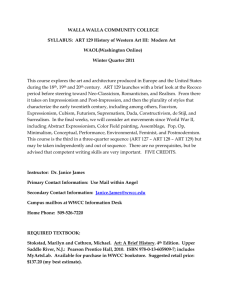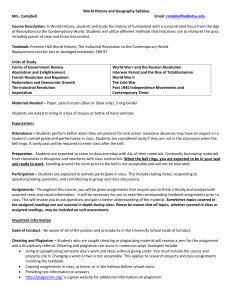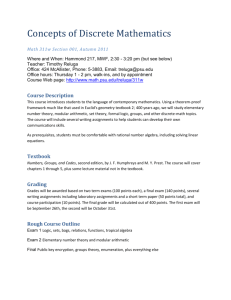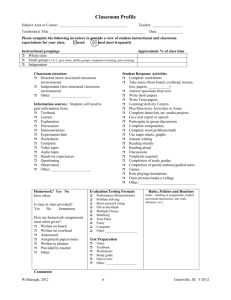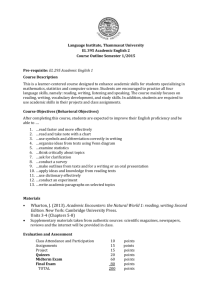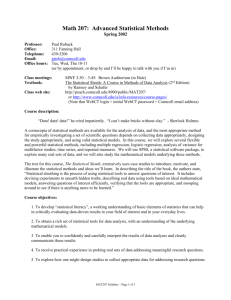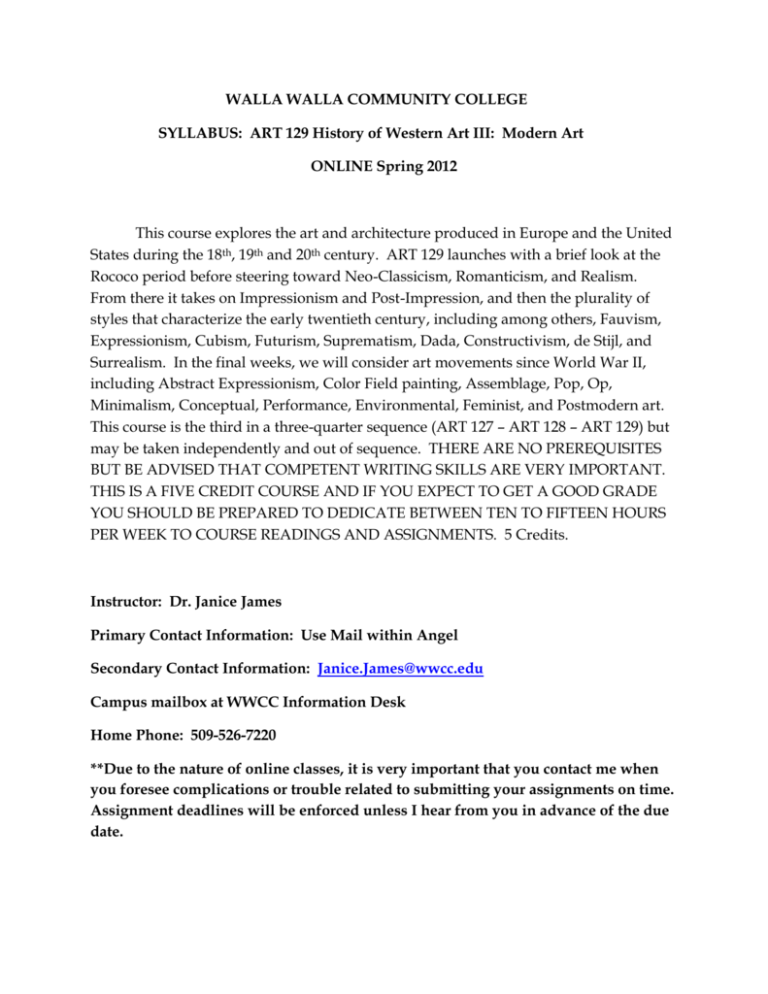
WALLA WALLA COMMUNITY COLLEGE
SYLLABUS: ART 129 History of Western Art III: Modern Art
ONLINE Spring 2012
This course explores the art and architecture produced in Europe and the United
States during the 18th, 19th and 20th century. ART 129 launches with a brief look at the
Rococo period before steering toward Neo-Classicism, Romanticism, and Realism.
From there it takes on Impressionism and Post-Impression, and then the plurality of
styles that characterize the early twentieth century, including among others, Fauvism,
Expressionism, Cubism, Futurism, Suprematism, Dada, Constructivism, de Stijl, and
Surrealism. In the final weeks, we will consider art movements since World War II,
including Abstract Expressionism, Color Field painting, Assemblage, Pop, Op,
Minimalism, Conceptual, Performance, Environmental, Feminist, and Postmodern art.
This course is the third in a three-quarter sequence (ART 127 – ART 128 – ART 129) but
may be taken independently and out of sequence. THERE ARE NO PREREQUISITES
BUT BE ADVISED THAT COMPETENT WRITING SKILLS ARE VERY IMPORTANT.
THIS IS A FIVE CREDIT COURSE AND IF YOU EXPECT TO GET A GOOD GRADE
YOU SHOULD BE PREPARED TO DEDICATE BETWEEN TEN TO FIFTEEN HOURS
PER WEEK TO COURSE READINGS AND ASSIGNMENTS. 5 Credits.
Instructor: Dr. Janice James
Primary Contact Information: Use Mail within Angel
Secondary Contact Information: Janice.James@wwcc.edu
Campus mailbox at WWCC Information Desk
Home Phone: 509-526-7220
**Due to the nature of online classes, it is very important that you contact me when
you foresee complications or trouble related to submitting your assignments on time.
Assignment deadlines will be enforced unless I hear from you in advance of the due
date.
REQUIRED TEXTBOOK:
Stokstad, Marilyn and Cothren, Michael. Art: A Brief History. 4th Edition. Upper
Saddle River, N.J.: Pearson Prentice Hall, 2010. ISBN 978-0-13-605909-7; includes
MyArtsLab when purchased new. Available for purchase in WWCC bookstore.
As an alternative, you may buy an access card from the WWCC Bookstore that
includes the entire ebook and MyArtsLab for Stokstad and Cothren, Art: A Brief
History, 2010. ISBN-10: 0205789684; Access Code Card.
MyArtsLab is an online resource provided by the publisher of your textbook. It is
described as “a robust online learning environment”. If you purchase a new
textbook or ebook, you will be able to link to MyArtsLab. In consideration of
students who may buy a used copy of the textbook, I do not require that you have or
use MyArtsLab. If you do use it, please feel free to forward your evaluation of it to
me.
In the past, students have bought used textbooks from Amazon.com. Also, at least
one student rented his textbook from an online source. I have included a link to an
article from The New York Times on the Course Announcement page which may
suggest other useful options if you do not intend to purchase a new book. If you do
buy used, BE SURE TO PURCHASE THE CORRECT EDITION OF THE BOOK
(fourth edition).
**It is critically important that you have a copy of the correct textbook in your
possession by the first day of class, Monday, March 26th.
COURSE GOALS: Upon successful completion of this course, you should be able to:
*Understand the aspirations and aims of numerous art styles and movements;
*Identify artists associated with these movements and distinguish a number of
personal artistic styles;
*Appreciate the close relationship between art and the political and social context
in which it occurs;
*Consider the importance of the advent of photography and its consequences for
art, particularly painting;
*Follow the development of architecture from its pre-modern roots through
innovations in style, building material, technology, function, and attitude;
*Understand the rise of “avant-garde” art in opposition to artistic traditions
supported by established authorities, especially the national academies of art;
*Be aware of the meaning of the terms “abstraction” and “nonrepresentational”
and recognize their value to modern artists;
*Understand the challenges presented by new art forms, such as the
“readymade,” collage, and assemblage, and methods like “appropriation,” to accepted
assumptions regarding aesthetics and the art object;
*Be aware of the ever-widening arena in which the visual arts take place,
involving interrelationships between traditional categories of art, music, theater, and
dance;
*Recognize that contemporary artists use art to engage social, political, cultural,
and religious issues;
*Be able to speak and write articulately and knowledgeably about modern
Western art;
*Nurture a long-lived interest in the arts and places studied in this course.
COURSE SCHEDULE:
Unit One/Mar 26 – Apr 2:
Preparing for Modern Art
Unit Two/Apr 3 – Apr 9:
The Eighteenth Century, otherwise called the Age of
Enlightenment or the Age of Reason
Unit Three/Apr 10 – Apr 16:
Neoclassical and Romantic Painting
Unit Four/Apr 17 – Apr 23:
Realism and other tastes
Unit Five/Apr 24 – Apr 30:
Impressionism and Post-Impressionism
Unit Six/May 1 – May 7:
MIDTERM
Unit Seven/May 8 – May 14:
Early Modernism in Europe and the United States
Unit Eight/May 15 – May 21:
European and American Art between WWI & WWII
Unit Nine/May 22 – May 28:
Art Since 1945/Part I
Unit Ten/May 29 – June 4:
Art Since 1945/Postmodernism
Unit Eleven/June 5 – June 7:
Final Exam
UNIT COMPONENTS:
**Each weekly unit, except for Unit One, begins at 12:05 a.m. on Tuesday and ends
the following Monday at 11:55 p.m. Please observe specific assignment deadlines.
(See below.)
For each weekly unit, you will find an assortment of components. I have tried to
make each unit basically consistent so that you will learn what to expect while
allowing for some variation. Unit Six is reserved for the Midterm exam, and the
Final exam is scheduled for Unit Eleven. THIS CLASS IS DESIGNED FOR YOU TO
RECALL COURSE MATERIAL FROM EARLIER WEEKS, AND THE MIDTERM
AND FINAL ARE ALSO CUMULATIVE.
Each weekly unit contains:
READINGS from the textbook, Art: A Brief History. I consciously picked a
textbook that was not overly burdensome in regard to reading load and cost. As you
will see, I typically supplement textbook assignments with additional required
online readings.
EXPLORATORY ACTIVITES are web visits added to enhance course topics.
WEEKLY GRADED ASSIGNMENTS include *multiple choice quizzes and art
vocabulary matching exercises based on the reading. An essay question (one usually,
rarely two), **discussion forum, and ***mystery image (one or more) are also
regularly included. The Midterm and Final exams also include a discussion forum,
mystery images, and/or essays.
*Multiple choice quizzes and art vocabulary matching exercises must be
completed by Friday so that you will be familiar with unit topics, concepts, issues,
ideas, artworks, and relevant vocabulary words which you are expected to use in your
written assignments (discussion forum posts, essays, and mystery images).
**A discussion forum is an interactive assignment designed for you to
articulate well-founded opinions and swap ideas with fellow students. You must
post an initial response and comment on TWO fellow students’ posts in order to get a
passing grade. IT IS IMPORTANT FOR YOU TO POST YOUR INITIAL RESPONSE
WELL IN ADVANCE OF THE UNIT DEADLINE IN ORDER TO GIVE FELLOW
STUDENTS AMPLE OPPORTUNITY TO COMMENT. Please note, therefore, that
your initial post is due by Friday and your two responses are due by Monday, 11:55
p.m. For full credit (the highest grade) your initial post and two replies need to be
substantive (rich with meaning) and well-written. Don’t forget to include works of
art that are documented correctly – include artist’s name, title, and date in
parentheses; if architecture, include location.
***A mystery image is a work of art that I presume you have not seen before,
but should be comfortable attributing to an artist or art historical period that we are
studying due to stylistic similarities, subject, technique, or another relatable measure.
*It may be that you know or otherwise can positively identify the mystery image in
which case you must still relate the mystery image to this course and relevant
subjects and artists under study.
ANGEL provides DROP BOXES where you will submit answers, written in
Word, to the essay questions and mystery images. *Before submitting a Word
Document to ANGEL, Save As “Word 97-2003” Document. By doing this, we can
avoid potential computer incompatibility issues. Always make a copy of your
written assignments since we cannot always predict what will happen in the cyber
world between your computer and mine. Please always safeguard against potential
loss and always submit your assignments to the correct Drop Box. (It becomes
confusing when you don’t.)
LATE WORK POLICY: I strongly encourage you to abide by the posted deadlines
and submit your assignments on time. IF YOU ARE UNABLE TO MAKE A
DEADLINE, YOU NEED TO CONTACT ME VIA ANGEL EMAIL IMMEDIATELY.
If I am notified, I will tolerate a rare late submission; however, if I see a pattern of
lateness emerging, I will warn you and then impose a strict grade-demotion penalty
for further lateness. If you can foresee a problem or if an emergency arises, please
contact me at once and together we can arrange a mutually agreeable plan of action.
PLAGIARISM: Understand that plagiarism is a serious academic offense and will
not be tolerated. DO NOT SUBMIT ASSIGNMENTS CONTAINING TEXT THAT
YOU HAVE COPIED, LIFTED, SHUFFLED, OR OBVIOUSLY MANIPULATED
FROM YOUR TEXTBOOK OR ANY OTHER SOURCE. Any instance of plagiarism
will be dealt with severely. You will certainly get a zero for that assignment, and
disciplinary action from Walla Walla Community College may be initiated. Repeat
plagiarism (twice) earns an F in the class and an incident report to WWCC
administration, including the Financial Aid Office if applicable. The concept of
plagiarism also includes allowing another person to submit work in your name in
this class.
GRADING: Your final grade will be determined by calculating assignments based
on the following percentages: weekly quizzes and vocabulary matching exercises
(10%), discussion forums (15%), mystery images (15%), essays (20%), Midterm (20%),
and Final (20%).
A
100 – 93%
C
77 - 73%
A-
92 – 90%
C-
72 – 70%
B+
89 – 88%
D+
69 – 68%
B
87 – 83%
D
67 – 63%
B-
82 – 80%
D-
62 – 60%
C+
79 – 78%
F
59% and below
For information regarding specific WWCC policies related to Disabilities, Plagiarism,
and on-campus student support services, go to the Lessons tab and click on TIPS and
Course Resources.




